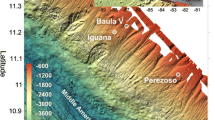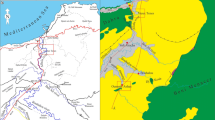Abstract
Ikaite is a rare form of carbonate – calciumcarbonate hexahydrate (CaCO3·6H2O) and isthe precursor to thinolites. Metastable 'ikaite'crystals, discovered in unconsolidated marinesediments in the King George Basin in the BransfieldStrait, Antarctica, are related to diageneticremineralization reactions of organic matter. StableC, O, and H-isotopes track the response of ikaitecrystals, during growth, to changing interstitialfluid conditions as a result of bacterial sulphatereduction and methanogenesis. Ikaites form inpreference over calcite or aragonite at the prevailingsurface sediment conditions of -1.6 °C and 200bar in the King George Basin.
The calcareous tufa towers of the terrestrial,hypersaline Mono Lake of northern California areCaCO3-precipitates formed by the influx ofsubmerged springs of calcium-rich freshwaters enteringthe alkaline lake (ΣCO2 = 0.5 m, pH =9.8). Under current climatic conditions the mineralcalcite precipitates, but during the colder Tiogaglacial period of Late Wisconsian age (12,000 to 9,000years BP), and possibly present day during the winterseason, the monoclinic calcium carbonate hexahydrate(ikaite) was the dominant phase formed. Thesepaleo-ikaites have since recrystallized to form thecalcitic pseudomorph 'thinolites'. They are foundelsewhere in recent and ancient sediments of polarregions, e.g., as 'glendonites'. The environmentaloccurrence of ikaites and their pseudomorphs deem themas potential paleoclimatic indicators of coldenvironments. The larger crystals are typicallyrestricted to colder, deeper organic-rich sediments orin moderately evaporitic basins. In these cases, theikaite formation and decomposition may be influencedby additives such as phosphate or amino acids.
Similar content being viewed by others
References
Allan, O. D. (1884) Geological history of Lake Lahontan, a quarternary lake of northwestern Nevada. In: I. C. Russell (ed.), USGS Monograph. 11, Washington, 1985, 203 p.
Bischoff, J. L., Stine, S., Rosenbauer, R. J., Fitzpatrick, J. A., and Stafford, T. W. Jr. (1993a) Ikaite precipitation by mixing of shoreline springs and lake water, Mono Lake, California, USA. Geochim. et Cosmochim. Acta. 57, 3855–3865.
Bischoff, J. L., Fitzpatrick, J. A., and Rosenbauer, R. J. (1993b) The solubility and stabilization of ikaite (CaCO3·H2O) from 0 °C to 25 °C: Environmental and paleoclimatic implications for Thinolite Tufa. J. Geol. 101, 21–33.
Boggs, S. Jr. (1972) Petrography and geochemistry of rhombic calcite pseudomorphs from mid-Tertiary mudstones of the Pacific Northwest, USA. Sedimentology 19, 219–235.
Brooks, R., Clark, L. M., and Thurston, E. F. (1950) Calcium carbonate and its hydrates. Trans. Royal Soc. London Series, A 243. 861, 45–167.
Buchardt, B., Seaman, P., Düwel, L., Jenner, C., Dristiansen, A., Pedersen, G. H., Shearman, D. J., Stockmann, G., Thorbjørn, L., Vous, M., and Whiticar, M. J. (1997) Ikaite columns in SW Greenland: Extreme tufa growth from submarine springs discharging a carbonatite complex. Nature 390(6656), 129–130.
Clarkson, J. R., Price, T. J., and Adams, C. J. (1992) Role of metastable phases in the spontaneous precipitation of calcium carbonate. J. Chem. Soc. Faraday Trans. 88, 243–249.
Cohen, L. H. (1966) Magnesium phosphate mineral, replacement at Mono Lake, Carlifornia. Amer. Mineralogist 51 Nov.-Dec., 1755–1765.
Council, T. C. and Bennett, P. C. (1993) Geochemistry of ikaite formation at Mono Lake, California: Implications for the origin of tufa mounds. Geology 21 971–974.
Chatard, T. M. (1889) In: I.C. Russell (ed.), Quarternary history of Mono Valley, California, 1889. USGS 8th Ann. Report pp. 290, 293, and 296.
Dana, E. S. (1884) A crystallographic study of the thinolite of Lake Lahontan. Bull. USGS No. 12, 425–454.
David, T., Edgeworth, W., and Taylor, T. G. (1905) Occurrence of the pseudomorph Glendonite in New South Wales, Part 1. New South Wales Geol. Sur. Rec. VIII, pp. 162–172.
Dickens, B. and Brown, W. E. (1970) The crystal structure of calcium carbonate hexahydrate at-120 °C. Inorganic Chemistry. 9, 480–486.
Dunn, J. R. (1950) Geology of the western Mono Lake area, California. California University, Berkeley, Ph.D. thesis.
Dunn, J. R. (1953) The origin of the deposits of tufa in Mono Lake, California. J. Sed. Petrol. 23, 18–23.
England, B. M. (1976) Glendonites, their origins and descriptions. Mineral Record 7, 60–68.
Freiesleben, R. (1827) Isis 10, 335 cited in Dana, 1884.
Garrels, R. M. and Christ, C. L. (1965) Solutions, Minerals, and Equilibria. New York: Harper and Row Publishers.
Haidinger, W. (1841) Ñber eine neue Localität von Gaylussit-pseudomorphosen. Poggendorff's Annalen der Physik. Leipzig. 53, 142–144.
Hathaway, J. C. and Degens, E. T. (1969) Methane-derived marine carbonates of Pleistocene age. Science 165, 690–692.
Hudson, J. D. (1977) Stable isotopes and limestone lithifications. J. Geol. Soc. London. 133, 637–660.
Hull, H. and Turnbull, A. G. (1973) A thermochemical study of monohydrocalcite. Geochimica et Cosmochim. Acta. 37, 685–694.
Hume, J. and Topley, B. (1926) The density of calcium carbonate hexahydrate. Chemical Society J. pp. 2932–2934.
Hume, J. and Topley, B. (1927) The rate of decomposition of calcium carbonate hexahydrate. Proc. Leeds Phil. Lit. Soc. 1, 169–176.
Jellison, R. (1996) Organic matter accumulation in sediments of hypersaline Mono Lake during a period of changing salinity. Limnol. and Oceanog. 41, 1539–1544.
Johnston, J., Merwin, H. E., and Williamson, E. D. (1916) The several forms of calcium carbonate. Amer. J. of Sci. 41, 473–513.
Kaplan, M. E. (1978) Kal'citovye psevdomorfozy v jurskich i niznemelovych otlozenijach severa vostocnoj Sibiri (Calcitic pseudomorphs in Jurassic and Lower Cretaceous deposits from the northern part of eastern Siberia). Geologija i Geofizika 12, 62–70.
Kemper, E. and Schmitz, H. H. (1981) Glendonite-Indikatoren des polarmarinen Ablagerungsmilieus. Geol. Rundschau. 70, 759–773.
Kemper, E. (1987) Das Klima der Kreidezeit. Geol. Jahrbuch A 91.
Kennedy, G. L., Hopkins, D. M., and Pickthorn, W. J. (1987) Ikaite, the glendonite precursor, in estuarine sediments at Barrow, Arctic Alaska. 100th Ann. Mtg, Oct, 1987, Abstr. GSA Bull. 19, 725.
King, C. (1878) United States systematic geology of the fortieth parallel. V I: Systematic Geology, pp. 512–525.
Lajoie, K. R. (1968) Quarternary stratigraphy and geologic history of Mono Basin, Eastern California. Ph.D. thesis, University of California, 271 p.
Leconte, J. (1879) On the extinct volcanoes about Lake Mono and their relation to glacial drift. Amer. J. of Sci. 18, 35–44.
Marland, G. (1975) Stability of calcium carbonate hexahydrate (ikaite). Geochim. Cosmochim. Acta. 39, 83–91.
Milliman, J. D. (1974) Marine carbonates. Part I of Recent Sedimentary Carbonates. Springer Verlag, Berlin 375 p.
Oremland, R. S., Miller, L. G., and Whiticar, M. J. (1987) Sources and flux of natural gases from Mono Lake, California. Geochim. Cosmochim. Acta. 51, 2915–2929.
Pauly, H. (1963) IKAIT, Nyt mineral der danner skaer. Naturens Verden June, 168–171, 186-192.
Pelouze, J. (1831) Sur la production artificielle due carbonate de chaux cristallise, et sur deux combinaisons de ce sel avec l'eau. Annales de Chimie et de Physique 2, 301–307.
Putnam, W. C. (1949) Quaternary geology of the June Lake district, California. Geol. Soc. Am. Bull. 60, 1281–1302.
Russell, I. C. (1883) Sketch of the geological history of Lake Lahontan, a Quarternary lake of northwestern Nevada. USGS Ann. Rept. 1881-1882, pp. 189–235.
Russell, I. C. (1889) Quaternary history of Mono Valley, California. USGS 8th Ann. Report pp. 261–394.
Schultz, B. P. (1996) The glendonite type pseudomorphs of Northern Jutland. Geologisk Institut. Aarhus, Denmark, 6 p.
Shearman, D. J. and Smith, A. J. (1985) Ikaite, the parent mineral of jarrowite-type pseudomorphs. Proc. Geol. Assoc. 96, 305–314.
Stine, S. (1988) The future of Mono Lake, Appendix D. University of California Water Resources Center Report. 68, 134 p.
Stein, C. and Smith, A. J. (1985) Authigenic carbonate nodules in the Nankai Trough, Site 583. In: H. Kagami, D. E. Karig, W. T. Coulbourn et al. (eds), Init. Repts. DSDP 87, Washington (U.S. Govt. Printing Office), pp. 659–668.
Suess, E., Balzer, W., Hesse, K. F., Müller, P. J., Ungerer, P. J., and Wefer, G. (1982) Calcium carbonate hexahydrate from organic-rich sediments of the Antarctic shelf: precursor of glendonites. Science 1216, 1128–1131.
van Valkenburg, A., Mao, H. K., and Bell, P. M. (1970) Ikaite (CaCO3·H2O), phase more stable than calcite and aragonite (CaCO3) at high water pressure. Geophysical Laboratory (Washington) Year Book 70, 237–238.
Whitehead, H. A. and Feth, J. H. (1961) Recent chemical analyses of waters from several closed basin lakes and their tributaries in the western United States. Geol. Soc. Am. Bull. 72, 1421–1426.
Whitney, J. D. (1865) Geology of California, Vol. I, California Geological Survey, Report of Progress and Synopsis of the Field Work from 1860-1864. Philadelphia, Caxton Press, 498 p.
Whiticar, M. J. and Faber, E. (1986) Methane oxidation in sediment and water column environments - isotope evidence. Advances in Organic Chemistry 1985 (12th EAOG meeting), Org. Geochim. 10, 759–768.
Whiticar, M. J., Faber, E., and Schoell, M. (1986) Biogenic methane formation in marine and freshwater environments: CO2 reduction vs. acetate fermentation-isotope evidence. Geochem. Cosmochim. Acta 50, 693–709.
Whiticar, M. J., Suess, E., Wefer, G., and Müller P. J. (1998) Calcium carbonate hexahydrate (ikaite): History of mineral formation as recorded by stable isotopes. Geochim. et Cosmochim. Acta (submitted).
Whiticar, M. J. and Suess, E. (1988) Non-Smokers: The Cold Carbonate Link Between Mono Lake, California and the Bransfield Strait, Antarctic. 12th European Assoc. Org. Geochem. Meeting, Venice, 1987, Abstract.
Rights and permissions
About this article
Cite this article
Whiticar, M.J., Suess, E. The Cold Carbonate Connection Between Mono Lake, Californiaand the Bransfield Strait, Antarctica. Aquatic Geochemistry 4, 429–454 (1998). https://doi.org/10.1023/A:1009696617671
Issue Date:
DOI: https://doi.org/10.1023/A:1009696617671




